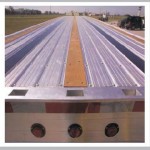Environmentally Friendly Flooring Options for Bathrooms
Selecting the appropriate flooring for a bathroom involves balancing aesthetics, durability, and functionality, particularly resistance to moisture. Increasingly, environmental considerations are also playing a significant role in flooring choices. Environmentally friendly flooring options offer a way to minimize ecological impact while still achieving a beautiful and practical bathroom space. This article will explore various sustainable flooring choices suitable for bathrooms that prioritize both performance and environmental responsibility.
The environmental impact of flooring encompasses several factors, including the sourcing of raw materials, manufacturing processes, transportation, installation, and end-of-life disposal or recycling. Traditional flooring materials, such as vinyl and some types of tile, can contribute to pollution and resource depletion. Environmentally friendly alternatives aim to mitigate these effects by utilizing renewable resources, minimizing waste, reducing emissions during production, and offering longer lifespans.
Key Considerations for Eco-Friendly Bathroom Flooring
When choosing environmentally friendly bathroom flooring, there are several vital characteristics to consider. These factors will ensure that the selected material not only minimizes its environmental footprint but also performs well in the humid and demanding environment of a bathroom.
Firstly, water resistance is paramount. Bathrooms are inherently wet environments, and flooring materials must be able to withstand constant exposure to moisture without warping, rotting, or developing mold. The material’s ability to maintain its structural integrity and appearance despite humidity and spills is crucial for longevity and hygiene.
Secondly, durability and longevity are essential aspects of sustainability. A flooring material that lasts longer reduces the need for frequent replacements, thereby decreasing waste and the associated environmental impact of manufacturing and disposal. The floor should be able to withstand daily wear and tear, resist scratches, and maintain its aesthetic appeal over time.
Thirdly, the material's composition and manufacturing process should be examined. Look for flooring options made from recycled content, renewable resources, or materials produced using environmentally responsible manufacturing practices. Certifications from reputable organizations, such as the Forest Stewardship Council (FSC) for wood products or Cradle to Cradle certification for various materials, can provide assurance of a product's environmental credentials.
Finally, ease of maintenance plays a role in the overall sustainability of bathroom flooring. Materials that are easy to clean and require minimal harsh chemicals for upkeep contribute to a healthier indoor environment and reduce the environmental impact of cleaning products. The ease of repair, should damage occur, also impacts the lifespan and reduces the need for full replacement.
Specific Eco-Friendly Bathroom Flooring Options
Several flooring materials meet the criteria for environmentally friendly bathroom options. These materials vary in their composition, aesthetics, and performance characteristics, allowing homeowners to choose a solution that aligns with their specific needs and preferences. The following are some of the more popular choices.
Cork Flooring: Cork is a renewable resource harvested from the bark of cork oak trees without harming the tree itself. It is naturally water-resistant, making it suitable for bathrooms. Cork flooring offers a comfortable, cushioned feel underfoot and is naturally antimicrobial, inhibiting the growth of mold and bacteria. Its inherent insulation properties also contribute to energy efficiency by helping to maintain a stable room temperature. However, some cork flooring requires sealing to enhance its water resistance, and it can be susceptible to scratches and dents if not properly maintained.
Bamboo Flooring: Bamboo is a rapidly renewable resource, making it a sustainable alternative to hardwood. It is durable and water-resistant when properly treated, making it a viable option for bathrooms. Bamboo offers a similar aesthetic to hardwood but with a significantly faster growth rate. However, the quality of bamboo flooring can vary depending on the manufacturing process, and some products may contain formaldehyde-based adhesives. It's important to choose bamboo flooring with low or no VOC (volatile organic compounds) emissions.
Reclaimed Wood Flooring: Reclaimed wood flooring is salvaged from old buildings, barns, or other structures. Using reclaimed wood reduces the demand for newly harvested timber and gives a unique character to the bathroom. It is durable and can be refinished to suit different aesthetic preferences. However, reclaimed wood may require careful cleaning and treatment to ensure it is free from pests and contaminants. Moreover, proper sealing is crucial to protect it from moisture damage in a bathroom environment.
Linoleum Flooring: Linoleum is made from natural, renewable materials such as linseed oil, rosin, wood flour, cork dust, and limestone. It is naturally antimicrobial, water-resistant, and durable, making it an excellent choice for bathrooms. Linoleum is also biodegradable, further minimizing its environmental impact. It is available in a wide range of colors and patterns, offering design flexibility. However, linoleum requires proper installation to prevent moisture from seeping underneath, and some varieties may require ongoing sealing for optimal performance.
Recycled Glass Tile: Recycled glass tile is made from post-consumer or post-industrial glass waste. It is durable, water-resistant, and adds a unique aesthetic to the bathroom. Using recycled glass reduces the amount of waste sent to landfills and conserves natural resources. Recycled glass tile is available in a variety of colors, shapes, and sizes, allowing for creative design possibilities. Its inherent resistance to moisture and stains makes it a practical and environmentally friendly choice.
Natural Stone Tile: While quarrying natural stone can have environmental consequences, some stones are more sustainable than others. Look for stones that are locally sourced to reduce transportation emissions and ensure responsible quarrying practices. Natural stone tiles like slate and granite are durable and water-resistant, making them suitable for bathrooms. They offer a timeless and elegant aesthetic. However, some natural stones may require sealing to prevent staining and water damage, and their weight can necessitate a reinforced subfloor.
The Importance of Installation and Maintenance
The environmental impact of bathroom flooring extends beyond the choice of materials. Proper installation and maintenance practices are vital to maximizing the lifespan and minimizing the overall environmental footprint of the flooring.
Proper installation is crucial to prevent moisture damage and ensure the longevity of the flooring. Gaps between tiles or planks, improper sealing, or inadequate subfloor preparation can lead to water infiltration, mold growth, and premature deterioration of the flooring. Hiring a qualified installer with experience in working with the chosen material is essential.
Using low-VOC adhesives and sealants is also crucial for minimizing indoor air pollution. Traditional adhesives and sealants can release harmful chemicals into the air, impacting indoor air quality and potentially posing health risks. Opting for products with low or no VOC emissions contributes to a healthier indoor environment.
Regular cleaning and maintenance are essential for preserving the appearance and extending the lifespan of bathroom flooring. Use environmentally friendly cleaning products that are free from harsh chemicals. Avoid abrasive cleaners that can damage the surface of the flooring. Regular sweeping or vacuuming to remove dirt and debris, followed by gentle cleaning with a mild detergent and water, is typically sufficient for most eco-friendly flooring options.
Addressing spills and water damage promptly is crucial to prevent staining and moisture damage. Wipe up spills immediately and ensure proper ventilation to allow the flooring to dry thoroughly. For porous materials like cork or natural stone, consider applying a sealant regularly to enhance their water resistance.
When it comes to repairs, attempt to fix localized damage rather than replacing the entire floor. Replacing a single plank or tile is often possible with many flooring types, minimizing waste and reducing the need for new materials. Consult with a flooring professional to determine the best repair approach for the specific material and damage.
Ultimately, selecting environmentally friendly flooring for a bathroom involves a combination of careful material selection, responsible installation practices, and diligent maintenance. By prioritizing these factors, homeowners can create a beautiful and functional bathroom space that also minimizes its impact on the environment.

Design Matters Eco Friendly Bathroom Flooring Forward Build Remodel

17 Eco Friendly Bathroom Upgrade Ideas Extra Space Storage

Flooring Installation Tips Hardwood Alternatives S Overview Commercial Options Residential Solutions Maintenance Advice Ceramic Tiles Guide Laminate Benefits

Sustainable Bathroom Flooring Options For An Eco Friendly Home From The Forest Llc

17 Eco Friendly Bathroom Upgrade Ideas Extra Space Storage

Is A Heated Bathroom Floor Eco Friendly

9 Best Tile Options For Your Bathroom Floor

Bamboo Flooring Pros And Cons Forbes Home

Knowledge About Environmentally Friendly Porcelain Tile Sold Here
:strip_icc()/101676936-54a447362241481fb338be905602b612.jpg?strip=all)
Cork Floors For Bathrooms
Related Posts








